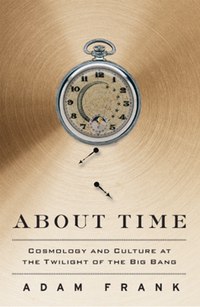|
|
Review: About Time
by Jeff Foust
Monday, September 17, 2012

About Time: Cosmology and Culture at the Twilight of the Big Bang
by Adam Frank
Free Press, 2012
softcover, 432 pp., illus.
ISBN 978-1-4391-6960-5
US$16
Many books have as their origins a single question to be studied, if not answered. In the case of astrophysicist Adam Frank, that question was raised by a student in one of his University of Rochester classes in 2007: “What happened before the Big Bang?” While an understandable question to ask, it’s similar to asking what’s south of the South Pole: the Big Bang is when the universe, and time, began. Or was it? “Now it appears that science is ready to go beyond, and before, the Big Bang,” he writes in the books’ prologue.
If this was a conventional book on cosmology, Frank would likely go from there into an exploration of the development of the Big Bang model of the formation of the universe and more recent efforts to propose models for what might have triggered the Big Bang in the first place—and thus give an idea for that “before” question raised in his class. However, Frank goes for a much broader scope in book, examining the concept of time itself, from both a scientific and cultural standpoint: how humans have perceived, and measured, time over the millennia, and how it has shaped our lives and civilization.
| Frank goes for a much broader scope in book, examining the concept of time itself, from both a scientific and cultural standpoint: how humans have perceived, and measured, time over the millennia, and how it has shaped our lives and civilization. |
That’s a tall order, but Frank delivers on it quite well in About Time, which is being released in paperback this month. Frank takes the reader through a broad sweep of human history, from the Paleolithic era to the present day, as civilization refines its concept of time. While our ancestors many thousands of years ago had only a general sense of time through daily, monthly, and annual cycles created by the Sun, Moon, and stars, today we measure time to an extreme level of precision, which shapes our lives accordingly. Frank examines those culture changes created by an increasingly precise measurement of time on topics as wide-ranging as the development of time zones, household appliances, and electronic mail.
Those more interested in the cosmological aspects of time, including the answer to that student’s question, also are well-served by the book, provided they’re a little patient. The latter portions of the book focus more on cosmology, including the development of the Big Bang and the inflation model to describe the earliest moments of the universe. He goes on to examine more recent developments, including proposals that the universe is one of many three-dimensional “world sheets” or “branes” in a higher dimensional space. The collision of two such branes could create conditions like those in the Big Bang model. That concept, as well as some other cutting-edge ideas like multiverses discussed in the book, can be a little difficult to grasp, but then, imagine a Paleolithic ancestor trying to understand how—and why—to measure time to a fraction of a second.
Jeff Foust (jeff@thespacereview.com) is the editor and publisher of The Space Review. He also operates the Spacetoday.net web site and the Space Politics and NewSpace Journal weblogs. Views and opinions expressed in this article are those of the author alone, and do not represent the official positions of any organization or company, including the Futron Corporation, the author’s employer.
|
|
